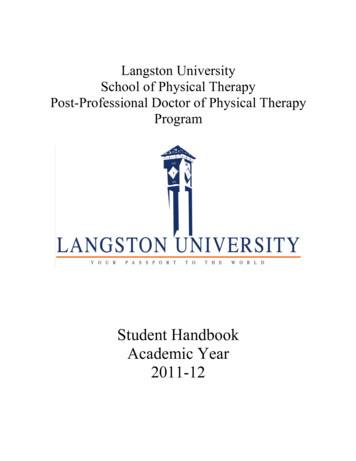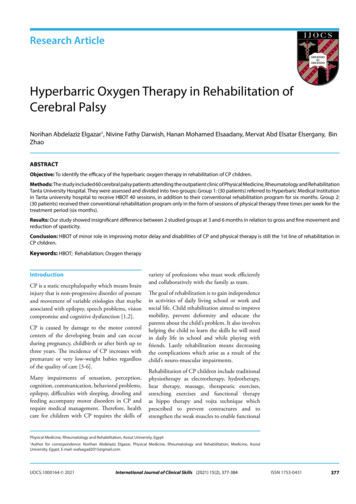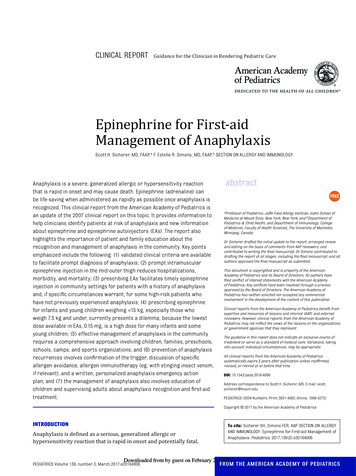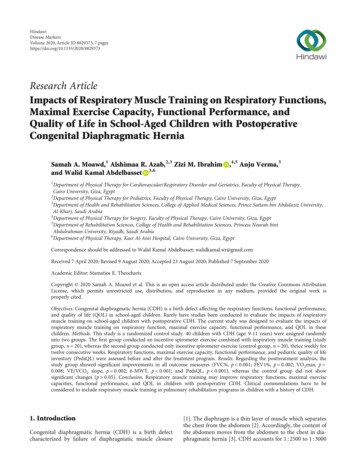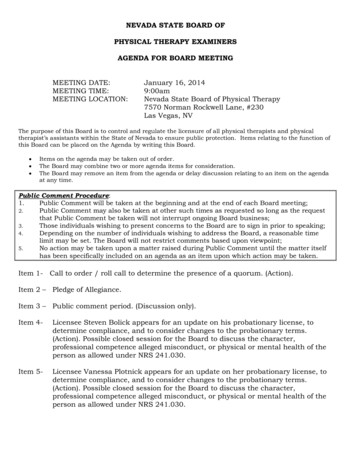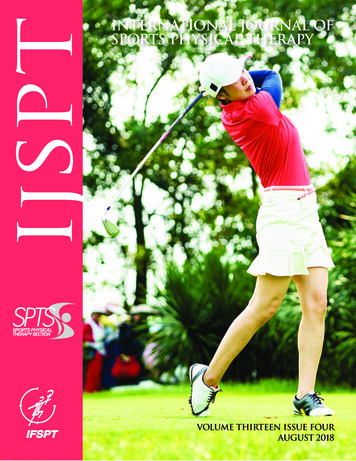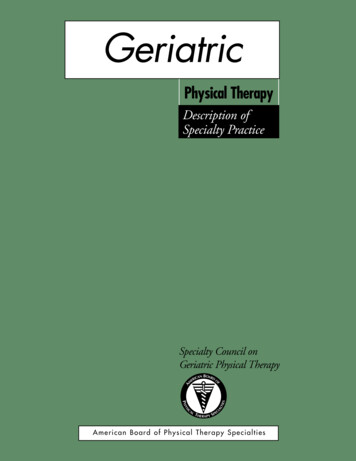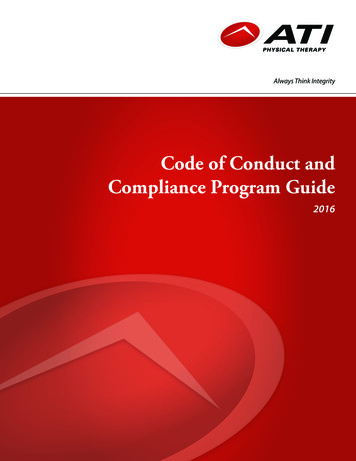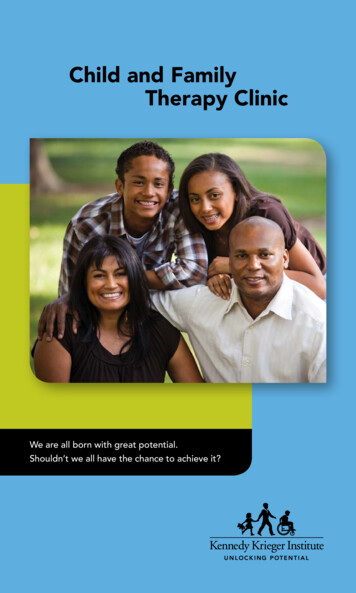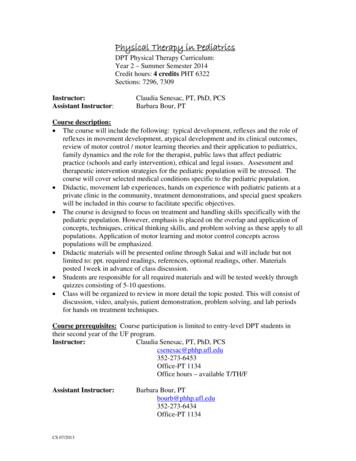
Transcription
Physical Therapy in PediatricsDPT Physical Therapy Curriculum:Year 2 – Summer Semester 2014Credit hours: 4 credits PHT 6322Sections: 7296, 7309Instructor:Assistant Instructor:Claudia Senesac, PT, PhD, PCSBarbara Bour, PTCourse description: The course will include the following: typical development, reflexes and the role ofreflexes in movement development, atypical development and its clinical outcomes,review of motor control / motor learning theories and their application to pediatrics,family dynamics and the role for the therapist, public laws that affect pediatricpractice (schools and early intervention), ethical and legal issues. Assessment andtherapeutic intervention strategies for the pediatric population will be stressed. Thecourse will cover selected medical conditions specific to the pediatric population. Didactic, movement lab experiences, hands on experience with pediatric patients at aprivate clinic in the community, treatment demonstrations, and special guest speakerswill be included in this course to facilitate specific objectives. The course is designed to focus on treatment and handling skills specifically with thepediatric population. However, emphasis is placed on the overlap and application ofconcepts, techniques, critical thinking skills, and problem solving as these apply to allpopulations. Application of motor learning and motor control concepts acrosspopulations will be emphasized. Didactic materials will be presented online through Sakai and will include but notlimited to: ppt. required readings, references, optional readings, other. Materialsposted 1week in advance of class discussion. Students are responsible for all required materials and will be tested weekly throughquizzes consisting of 5-10 questions. Class will be organized to review in more detail the topic posted. This will consist ofdiscussion, video, analysis, patient demonstration, problem solving, and lab periodsfor hands on treatment techniques.Course prerequisites: Course participation is limited to entry-level DPT students intheir second year of the UF program.Instructor:Claudia Senesac, PT, PhD, PCScsenesac@phhp.ufl.edu352-273-6453Office-PT 1134Office hours – available T/TH/FAssistant Instructor:CS 07/2013Barbara Bour, PTbourb@phhp.ufl.edu352-273-6434Office-PT 1134
Class time:Tuesday:Lecture 8:00-9:15Lab A: 9:30-12:00 (small group discussion, experiential learning,and demos)Lab B: 12:45-3:15 SAMEFriday:Lecture/Lab 8:30-12:30*Please be flexible on these days! Bringing patients and guest speakers in for classcan be unpredictable. We will do our best to keep to the schedule.Clinic Site:Kids on the Move1203 NW 16th Ave352-373-7337General Objectives: *** Specifics for each lecture will be given***1. Guide to PT Practice model and the ICF model:1.1. The student will recognize the differences in the application of these models tothe pediatric populations1.2. The student will develop treatment plans based on the Guide to PT Practicemodel.1.3. The student will apply the ICF model as they develop goals for the pediatricpopulation with regard to participation (play, school, community)2. Theories of motor control, motor learning, and motor development:1.1 Define identified motor control terminology.1.2 Discuss/explain factors influencing motor learning for skillacquisition.1.3 Explain factors that affect therapy interventions related to principles of motorlearning and motor control1.4 Discuss the relationship of motor learning to typical/atypicaldevelopment1.5 Demonstrate concepts of practice, feedback, stages of learning through labactivities and clinic experience related to this course1.6 Explain and demonstrate through lab and clinic experience related to class howlearned motor skills generalize to other untrained skills.1.7 Discuss the different types of attention and how they affect motor skill acquisitionand performance1.7.1 Demonstrate through treatment design how to address deficits inattention especially scanning attention1.8 The student will be able to analyze movement, design treatment, and modify POCbased on motor control and motor learning concepts.2. Typical Development and reflexes:2.1 Contrast respiratory rate, heart rate, and blood pressure between the newbornInfant and developing child up to a 5-6 year old child.2.2 Describe and discuss nervous system and musculoskeletal development.2.3 Discuss the implications of birth weight and its value as a predictor of typicaldevelopment.CS 07/2013
2.4 Describe the Apgar Scale and its purpose.2.5 Describe and compare typical characteristics of the full term infant andpremature infant2.6 Identify components of a newborn exam.2.7 Explain habituation and its significance with the neonate.2.8 Explain the testing procedures for, responses to, and significance ofdevelopmental reflexes and reactions.2.8.1 Recognize need to perform primitive reflex testing2.8.2 Ability to perform primitive reflex testing in the neurological patient2.9 Differentiate and discriminate between changes in development if pathologicalreflexes persist. This will be done through lab activities.3. Gross Motor Development:3.1 Describe and discuss gross motor progression from 0-2 years of age.3.2 Discuss the development of typical postural control: righting reactions,protective reactions, equilibrium reactions and balance.3.2.1 Perform facilitation techniques of postural reactions – will be donein lab activities and tested in competencies3.3 Analyze the movements and behavior of typical children between the ages of 0-12months and determine the demonstrated gross motor age of the child. This will bedone during lab activities and demonstrations “baby day”.3.4 Describe the progression of GM skills in children that demonstrate typicaldevelopment between the ages of 0-12 months3.5 Describe and recognize the progression of gait from automatic walking toindependent ambulation.3.6 Describe the physical requirements and prerequisites needed for ambulation.4. Fine Motor/Vision/Cognition/Sensory Processing:4.1 Describe and discuss development of reach and grasp patterns.4.2 Describe and discuss fine motor development.4.2.1 Be able to perform a FM screening to determine if referral necessaryto OT4.3 Identify the sequence in the development of FM skills4.4 Describe how vision contributes to environmental problem solving.4.5 Identify and describe how information processing is important in vision andFM control.4.6 Identify the sequence in the development of vision4.6.1 Perform a functional vision screening exam4.7 Describe and discuss the development of the sensory processing system4.7.1 discuss and demonstrate treatment techniques that would addresssensory processing deficits4.8 Identify the connection between cognition, FM skills, GM skills, and vision5. Postural Control:5.1 Discuss the basic principles for control of movement and posture.5.2 Identify, discuss, and demonstrate the balance strategies.CS 07/2013
5.2.1 perform facilitation of balance reactions: righting, equilibrium,protective extension5.3 Discuss guidelines that can be used to differentiate problems with head andtrunk control.5.4 Demonstrate treatment techniques for the child with head and trunk controlproblems.6. Atypical Development:6.1 Identify potential problem signs, soft signs, or “red flags” of development.6.2 Discuss the sequence of atypical motor development including missingcomponents, compensations, habit, possible contractures and deformities.6.3 Describe how atypical motor development can lead to problem areas.6.4 Discuss and describe the difficulties that can occur: neck, shoulder, pelvic-hipwhen atypical development is present.6.5 Demonstrate/Perform “select” treatment strategies for the neck, shoulder, pelvichip areas.6.6 Describe and be able to demonstrate pelvic positions and gait patterns notedwith atypical/pathological muscle tone.6.7 Analyze movement of a child by watching videotape and prioritize key areas thatinterfere with typical movements.6.8 Analyze movement of a child in clinic setting prioritizing key areas that interferewith typical movements.7. Adaptive Equipment:7.1 Discuss the role of adaptive equipment for the special needs child at home, inschool, in the community.7.2 Describe the criteria to consider when evaluating a special needs child for adaptiveequipment.7.3 Identify 5 criteria to address when purchasing adaptive equipment for the specialneeds child.8. Public Laws:8.1 Explain the overall purpose of the Education of the Handicapped Act and itsAmendments: the diagnostic criteria students must meet to qualify forspecial education services; the IEP, least restrictive environment, transitionservices8.2 Explain the overall purpose of Part C of PL 99-457, including: the emphasison the family, the IFSP, the differences between the IEP and the IFSP:eligibility requirements.8.3 Explain how a therapist determines educational relevance for a student toreceive services.8.4 Define and give examples of the terms: transdisciplinary, multidisciplinary,and interdisciplinary.8.4.1 differentiate the above terms9. Family/Client/Professional Communication:CS 07/2013
9.1 Describe benefits of family centered care.9.2 Describe barriers to family centered care.9.3 Demonstrate appreciation for cultural diversity as it influences treatment plan ofcare and family centered goals.9.4 Identify/describe characteristics of family impact related to having a disabled child9.5 Modify treatment POC, interaction with family and child as needed based oninteraction and cultural diversity.10. Guest Speakers:10.1 Describe impact of diagnosis on child/family based on lectures presented bychildren and /or family-assessed through discussion10.2 Describe personal impact on self- as a result of lecture by children and/or family.This will be assessed through discussion.11. Therapist Role:11.1 Discuss the role of the therapist in the treatment of children11.1.1With family, caregivers11.1.2With the medical community11.2 Understand the legal and ethical obligations to the child and family11.2.1 Child abuse11.2.2 Child neglect11.2.3 Family support12. Treatment Strategies:These will be assessed during competencies where the student will perform thetechniques on the instructor. These competencies are P/F however every criticalcomponent listed below must be passed. In the event that the student fails the competencyremediation will be arranged with one of the instructors and then re-testing will bearranged until the objectives are met.12.1 Student will be able to demonstrate/perform at least one technique each for thetreatment of the following: Facilitation of: 1) head control, 2) rolling, 3) getting intositting, 4) sit to standing, 5) gait, 6) other12.1.1 Appropriate hand placement12.1.2 Safety during movement transitions12.2 Student will be able to perform two techniques for inhibiting spasticity:12.2.1 Appropriate hand placement12.2.2 Safety during treatment12.3 Student will be able to demonstrate two techniques for facilitating tone:12.3.1 Appropriate hand placement12.3.2 Safety during treatment12.4 Student will be able to demonstrate facilitating postural reactions.12.4.1 Appropriate hand placement12.4.2 Safety during treatment12.5 Student will be able to demonstrate/perform a treatment progression12.5.1 Appropriate transitionsCS 07/2013
12.5.2 Safety during treatment13. Selected Pediatric Conditions:13. 1 Student will be able to describe/define selected pediatric conditions including butnot limited to: CP, torticollis, Pediatric oncology, sports injury, Down syndrome, Spinabifida, SMA, common orthopedic conditions, mitochondrial disorders, Marie CharcotTooth disease, Autism spectrum, and other 13.1.1 Differentiating diagnosis13.1.2 Differentiating prognosis13.1.3 Determining the correct pediatric practice pattern from the APTAGuide to PT Treatment13.2.4 Describe etiology, pathology, and signs/symptom13.2.5 Justify clinical disposition13.2.6 Describe, justify, determine role of PT in care14. Behavior Modification14.1 Define classic terminology related to behavior modification14.2 Describe concept of rewarding, reinforcing behaviors to enhance therapy outcomesTeaching Methods:This is a lecture/lab course. Part of the course is presented as a “Flip” classroom withmuch of the didactic work presented online with higher level learning including analysisand synthesis of the material done during class-time. The lectures will include formalpresentations including power point, videos, and class discussions. Labs will providemovement experiences and treatment strategies, including patient demonstrations,followed by discussion. Small group discussions will be led by students andsupervised/mediated by instructors. Patient interaction, student participation forsupervised hands on experience will be provided at a private clinic in the community.Students are expected to come to class prepared to participate having accessedpreparatory material online including but not limited to power point, required readings,and other required headings. Modules will be available through e-learning forindependent study in preparation for class, labs, and discussion. Individual objectives willbe listed for each module.Recommended textbooks as references:1.2.3.4.5.Umphred, DA. Neurological Rehabilitation 5th or 6th edition. Mosby Elsevier,2007 or 2012.Shumway-Cook A, Woollacott MH. Motor Control: Translating Research intoClinical Practice. 4th edition. Lippincott Williams & Wilkin 2011.Chen DJ, Martin ST. Functional Movement Development Across the Life Span,WB Saunders Company, 2nd edition 2002.Schmidt RA. Motor Control and Learning a Behavioral Emphasis, HumanKinetics, 4th or 5th edition, 2005 or 2011.Long, T, Toscano, K. Handbook of Pediatric Physical Therapy. LippincottWilliams & Wilkins, 2nd edition, 2002.CS 07/2013
6.7.8.9.Susan K. Effgen, Meeting the Physical Therapy Needs of Children, F.A.Davis2005. New one coming out soon!Drnach, M. The Clinical Practice of Pediatric Physical Therapy, From the NICUto Independent Living. Lippincott Williams & Wilkins, 2008.Tecklin, Jan S. Pediatric Physical Therapy, 4th edition 2007. Lippincott Williams& WilkinsDodd K.J., Imms C. and Taylor N.F., Physiotherapy and Occupational Therapyfor People with Cerebral Palsy: A Problem-Based Approach to Assessment andManagement. Mac Keith Press 2010.Additional readings: these will be designated required or optional.Selected readings may be assigned: These references are available through the HSCLibrary or from the instructor (posted on Sakai) and will include research articles onselected topics. These references will be designated as required and optional (for thosethat intend to pursue pediatrics). You will be tested on the required readings.Testing and grading:This course will be graded according to the departmental guidelines located in thestudent handbook. Attendance is required. There will be two written exams, bothconsisting of questions drawn from the readings, video, DVD/CD’s, lectures, handouts,and labs preceding the exam. Exams will include multiple choice, true/false, shortanswer, and essay. All exams/quizzes are cumulative. Please refer to the courseobjectives in the syllabus as a study guide for both reading assignments and exams. Therewill be a quiz/unit as listed in Sakai. One lab competencies will be given in the labportion of this class at the end of the semester. Details of which are described in theobjectives.For the final course grade, the student must achieve the full numerical grade to achievethe letter grade. For example, a final course grade of 82.99 is still a B- grade, but a finalgrade of 85.00 will be recorded as a B. There will be NO rounded up of grades.Grading:Exam I - midtermExam II – finalCumulativeQuizzes (10) 10 pts/eachPoints100150100Video Quizzes or assignments(max 5) 10 pts/eachKOM I50KOM II15Competency25TOTAL455CS 07/201315Grading scale93-100 A 4.00 grade point90-92 A- 3.67 grade point87-89 B 3.33 grade point83-86 B 3.00 grade point80-82 B- 2.67 grade point77-79 C 2.33 grade point73-76 C 2.00 grade point70-72 C- 1.67 grade point67-69 D 1.33 grade point63-66 D 1.00 grade point60-62 D- 0.67 grade pointBelow 60 E 0 grade point
Labs: Wear lab attire as specified in the student handout. You will be on the floorduring these labs. Socks may be worn during labs to protect the feet You will be askedto remove your shoes during lab and KOM periods.Setting up the classroom and lab, sweeping the floor, cleaning the mats, and preparing forguest speakers will be assigned by the week. This must be done at least 30 minutes priorto class period or on the break between lecture and lab.[LAB Set up will be lab A and break down will be lab B]Clinical ExperienceThis experience is to provide an opportunity for hands on learning under the supervisionof a pediatric therapist. The goal is to improve your handling skills, problem solving,critical thinking skills, and ready you for your clinical in the fall. There will be 2treatment sessions. You will be responsible for fulfilling your commitment with thepatient. Total points 30 pointsAcademic Honesty / Honor CodeIn this professional program we are particularly sensitive to students submittingindependent work and to using complete and accurate referencing in complying with theUniversity of Florida Rules - 6Cl- 4.0l7 Student Affairs: Academic Honesty Guidelines.Further details regarding the University of Florida honesty policy is available emicguide.php and in your studenthandbook. All students are required to abide by the Academic Honesty Guidelines, thefollowing pledge has been accepted by the University and is expected of all students:“We, the members of the University of Florida community, pledge to hold ourselvesand our peers to the highest standards of honesty and integrity”. On all worksubmitted for credit by students at the University of Florida, the following pledge iseither required or implied: "On my honor, I have neither given nor receivedunauthorized aid in doing this assignment."Policy Related to Class AttendanceAttendance is mandatory. Please contact the instructors as soon as possible if you areunable to attend class for any reason. Personal issues with respect to class attendance orfulfillment of course requirements will be handled on an individual basis.Policy Related to Make-up ExamsIn extraordinary circumstances it may be possible to take an exam early or late. If for anyreason you are unable to attend an exam at the last minute, you must notify the instructoras soon as possible. Personal issues with respect to exams will be handled on anindividual basis.Accommodations for students with disabilitiesIf you require classroom accommodation because of a disability, you must first registerwith the Dean of Students Office (http://oss.ufl.edu/).The Dean of Students Office willprovide documentation to you, which you then give to the instructor when requestingCS 07/2013
accommodation. The College is committed to providing reasonable accommodations toassist students in their coursework.Counseling and Student HealthStudents may occasionally have personal issues that arise in the course of pursuing highereducation or that may interfere with their academic performance. If you find yourselffacing problems affecting your coursework, you are encouraged to talk with an instructorand to seek confidential assistance at the University of Florida Counseling Center, 352392-1575, or Student Mental Health Services, 352-392-1171. Visit their web sites formore information: http://www.counsel.ufl.edu/ gentThe Student Health Care Center at Shands is a satellite clinic of the main Student HealthCare Center located on Fletcher Drive on campus. Student Health at Shands offers avariety of clinical services, including primary care, women's health care, immunizations,mental health care, and pharmacy services. The clinic is located on the second floor ofthe Dental Tower in the Health Science Center. For more information, contact the clinicat 392-0627 or check out the web site at: www.health.ufl.edu/shccCrisis intervention is always available 24/7 from: Alachua County Crisis Center: (352)264-6789. BUT – Do not wait until you reach a crisis to come in and talk with us. Wehave helped many students through stressful situations impacting their academicperformance. You are not alone - do not be afraid to ask for assistance.This course progresses at a rigorous pace. It is strongly recommended that you notfall behind. The first part of the course is heavy in foundational materials stay ontop of it. Assignments to prepare you for class are posted the week prior on Sakai.Come prepared to think out loud, ask questions, participate, and learn. Leaveyourself open to grow. It requires much team work, collaboration, imagination,creativity, energy, thinking outside the box, problem solving, critical thinking,analyzing, synthesizing information, and most importantly a sense of humor.Soooo BRING IT ON!!!CS 07/2013
Pediatrics in Physical Therapy – SCHEDULEPHT 6322, DPT program2nd year students – Summer 2014Tuesday:Quiz days: 7:45amLecture 8:00‐9:15Lab A: 9:30‐12:00Lab B: 12:45‐3:15Friday:UNIT 1 – Building a Pediatric Foundation: Birth to 6 yearsQuiz days: 8:15am**check schedule some exceptionsLecture/Lab 8:30‐12:30Instructor:Dr SenesacAssistant Instructor: Barb BourReflexesDevelopment of extension/flexionSkill acquisitionFunctional MovementMotor control/Motor learning concepts/application‐reviewDevelopmental interactions: GM, FM, Social, vision, Sensory, CommunicationWEEK ONEMay 13th TuesdayLecture‐ course introduction and overview Review of Embryology‐critical time periods.Required Readings posted on SakaiExcessive Stress Disrupts the Architecture of the Developing BrainEarly Exposure to Toxic substances Damages Brain ArchitectureThe Timing and Quality of Early Experiences combine to shape Brain ArchitectureBuilding the Brain’s “Air Traffic Control” System:Required power points posted on Sakai‐ prep for class on FridayPostural reactions, heart defects, other Required Links to videos/other informationDevelopmental Chart: across domainsDevelopmental Chart: ONLY GM skillsReflex testing‐ follow list of required videos to m/html/newborn n.html*if this link does not work: Google: infant neuro exam and follow link to Utah siteRequires QuickTime Player‐download for free***Take online Quiz when done with videosPediatric Section: What is a Pediatric PT (video online) www.pediatricapta.orgOptional Readings/references posted on SakaiLab‐ split A/B ( 1 ½ hours)Lecture continues Experiential movement labo Movement how does movement occur?May 16th Friday‐early start time: **Babies at 8:00 arrive 15 min early**
BABY DAY several babies will join us from 8:00‐10:00am Quiz after babies on ReflexesDVD the Baby Human‐To Walk‐Discovery ( 1 hour)Discussion afterwardWEEK TWOMay 20th TuesdayLecture Newborns, Atypical DevelopmentMotor learning/Motor control‐review, Characteristics of fetus/neonate, development of extension, skillacquisition, functional movement components, developmental interactions, reflexes,Continue with Unit 1Video analysis‐typical movement based on video of babies 4/17/13Required Readings posted on SakaiDevelopmental Skills 3‐6 yearsRequired power points posted on Sakai‐ prep for classRequired Links to videos/other informationOptional Readings/references posted on SakaiLab split A/B (follow objectives) Head control‐what is it, who needs it, how do you get it? Facilitating head control‐all positionsMay 23rd FridayLectureQuiz 8:15am Analyzing “typical” development Analyze Videos‐ typical development 0‐2 years Analyze videos‐ typical development 2‐6 years Begin process to analyze “atypical” developmentUnit 2 Assessment Tools and Objective OutcomesGeneral Characteristics‐ Selected ToolsStandardized toolsObjective measuresTimed testsOther Difference between functional assessment and impairment measuresSelecting the right toolSelecting goals based on results of assessment (s)Goal writing‐objective measures incorporated in goal and treatments
WEEK THREEMay 27th‐TuesdayLecture**7:45am Quiz8:00 ‐9:15am Guest lecturerLeanne Harrison‐Forbes‐ focus on standardized testing tools and use of selected tools including but notlimited to: GMFM, BOT‐2, PDMS‐2, AIMSRequired Readings posted on SakaiRequired power points posted on Sakai‐ prep for classGeneral information on assessment tools, terminology, etc Required Links to videos/other informationOptional Readings/references posted on SakaiLab split A/B (follow objectives)Guest Speaker‐continues Video analysis‐ testing toolso Scoring of items on selected toolso Discussion: meaning of results Goal setting based on resultsMay 30th Friday Demo ‐assessment (AF)Synthesize resultso Strengths, weaknesseso Identify foundation to build ono Goals/writing objectively Objective Measureso Muscle tone, Muscle testing, Timed Tests: 10 m walk, TUG, 2 min. walk, supine stand,ascend 4 stairs, Pediatric Balance Test, vestibular testing, vision dissociationGeneral assessment forms for evaluationsLab StationsWEEK FOURUnit 2 continuesJune 3rd TuesdayQuiz 7:45Lecture – video analysis (ET, AF, LA, AA)Lab Catch up‐ first hour‐discuss demo Facilitation of head control, rolling
June 6th FridayKids on the Move‐Plan all day 8:00‐3:00pm Assignment into groups/child to work withYou will use posture in pictures, general information formAssignment: fill in ICF chart and develop goals for patient as a groupo Objectives: communication skills with child, safety, handling skills, explanation of tasks,and justification of selected tools: SEE DETAILS posted on SakaiUnit 3: Treatment and Handling SkillsCriteria for Assessment: analyzing movementFacilitating and Inhibiting MovementGeneral BackgroundKey points of controlReinforcing key components during treatmentBasic SkillsMuscle Tone and TreatmentGeneral reviewHow to assess muscle toneManaging tone during treatmentTreatment ProgressionGuidelinesCircuit trainingComplex skillsWEEK FIVEJune 10th TuesdayLecture**7:45am Quiz Treatment strategies: Historical perspective/background [Ayers, Rood, Bobaths]o Development of ext/flex, controlled head/trunko Loading, WS, SSCRequired Readings posted on SakaiRequired power points posted on Sakai‐ prep for classGeneral information on assessment tools, terminology, etc Required Links to videos/other informationOptional Readings/references posted on Sakai
Lab Trunk control R/E/PEo Development of rolling, prop on elbow, up to sitting, into quadrupedJune 13th FridayLectureGuest Speaker: Kim Kazamore 8:30‐10:30Behavior management, motivation, and participation during therapy VideoDemo (AF) treatment/handlingUnit 3 ContinuesUnit 4 Special ConditionsCerebral Palsy, Torticollis, Down syndrome, and Erb’s PalsyWEEK SIXJune 17th TuesdayLecture**7:45am QuizHighlight special conditions, differential diagnosis of conditions: CP, DS, Torticollis, Erb’s PalsyRequired Readings posted on SakaiRequired power points posted on Sakai‐ prep for classGeneral information on assessment tools, terminology, etc Required Links to videos/other informationOptional Readings/references posted on SakaiLab Transitions: Quad kneeling ½ Kneeling standingJune 20thFridayLecture Kids Lecture / Adult with CPSchool System: review of public laws and educational modelsDemo (SZ) treatment/handling
Units 3 and 4 ContinueTreatment and Handling SkillsSpecial Conditions: Obesity, General Orthopedics, Sports Injury, PedOnc, General Physical FitnessWEEK SEVENJune 24th TuesdayLecture**7:45am QuizBarb Smith: respiration/cardioRequired Readings posted on SakaiRequired power points posted on Sakai‐ prep for classGeneral information on assessment tools, terminology, etc Required Links to videos/other informationOptional Readings/references posted on SakaiLab Combining respiration with exerciseVision Screen: dissociationStanding GaitJune 27th Friday‐Lecture –follows exam, see belowMID‐TERM EXAM Differential diagnosis of special conditionsUnits 3 and 4 ContinueTreatment and Handling SkillsSpecial Conditions: Degenerative Diseases (DMD, SMA), SB, MCT diseaseWEEK EIGHTJuly 2nd TuesdayLecture**7:45am QuizRebecca Wilcox: DMD research at UFRequired Readings posted on SakaiRequired power points posted on Sakai‐ prep for classGeneral information on assessment tools, terminology, etc
Required Links to videos/other informationOptional Readings/references posted on SakaiLab Billing Differential diagnosis Changing directions, obstacles, etcJuly 4th Friday‐NO CLASSUnits 3 and 4 ContinueTreatment and Handling SkillsSpecial Conditions: Autism spectrum, DCDREVIEW goals for KOMWEEK NINEJuly 8th TuesdayLecture: NICU, special care settings**7:45am QuizRequired Readings posted on SakaiRequired power points posted on Sakai‐ prep for classGeneral information on assessment tools, terminology, etc Required Links to videos/other informationOptional Readings/references posted on SakaiLab: other/catch upJuly 11th FridayKids on the Move‐Plan all day 8:00‐3:00pm Assignment into groups/child to work withTreatmento Objectives: TBD [to be developed]Unit 5 Adjunctive Modalities/TherapiesWEEK TENJuly 15th TuesdayLecture**7:45am Quiz
Highlights – discussion of alternative methods/ adjunctive therapiesRequired Readings posted on SakaiRequired power points posted on Sakai‐ prep for classGeneral information on assessment tools, terminology, etc Required Links to videos/other informationOptional Readings/references posted on SakaiLab Case Studies POC TreatmentJuly 18th FridayLecture Catch up/analysis/synthesisWEEK ELEVENJuly 22rd TuesdayQuiz 7:45Review for written exam 8:00Competency‐ groups will be assignedLab A between 9:30‐12:00Lab B between 12:45‐2:45July 25th FridayWritten exam 8:30‐10:00
the pediatric populations 1.2. The student will develop treatment plans based on the Guide to PT Practice model. 1.3. The student will apply the ICF model as they develop goals for the pediatric population with regard to participation (play, school, community) 2. Theories


